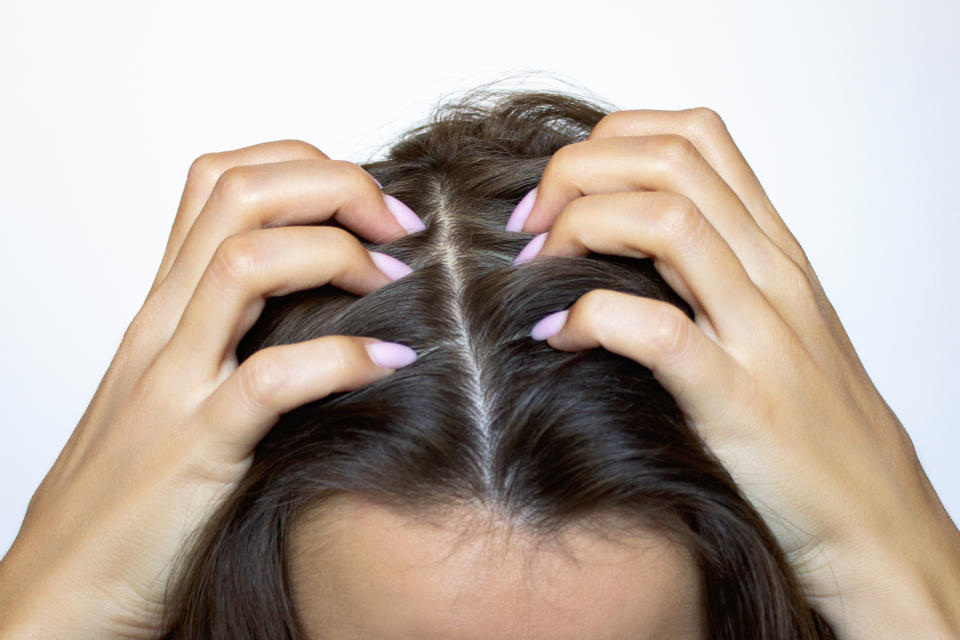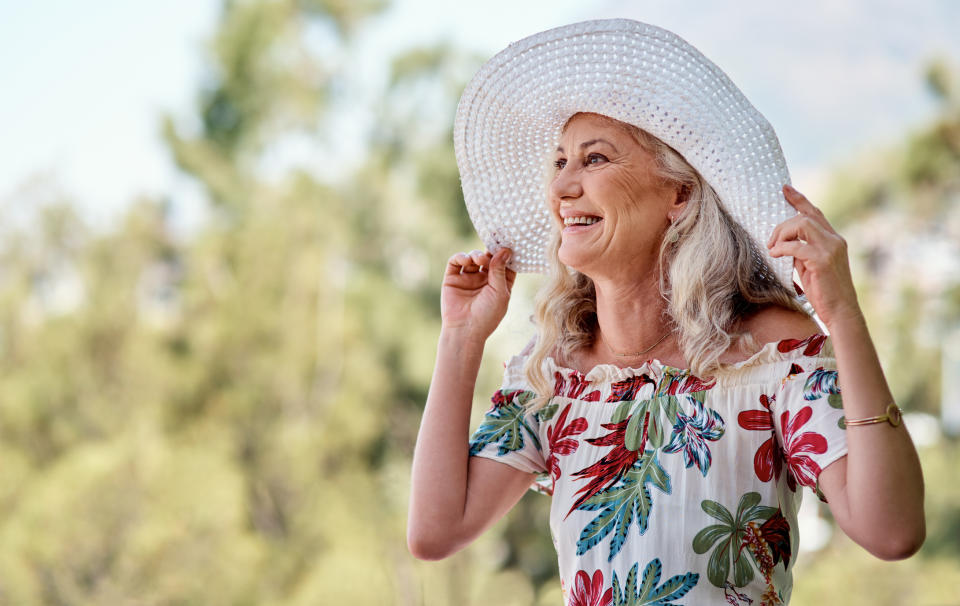How to Get Rid of Scalp Acne According to Top Dermatologists
Acne is usually associated with breakouts on the chin, cheeks, and nose. However, there’s another area of the head where acne can pop-up—your scalp. That’s right: Your scalp and hairline can be “hot beds” for bumps and redness. You may not easily see it when staring straight into a mirror, but you may feel the bumps and irritation. That's why we asked top hair and skin specialists about the root causes behind scalp acne and how to prevent and treat it.

What is scalp acne?
Overall, scalp acne is a term often used informally to describe small pimples or bumps that appear on the scalp, which technically aren’t always TRUE acne, says Alexandra Bowles, DO, a board-certified dermatologist at MONA Dermatology. “These bumps can be similar in appearance to acne lesions that occur on the face and body."
What causes scalp acne?

Scalp acne cause: Inflammation
"Scalp acne is typically caused by inflammation or infection of the hair follicles due to factors such as excess oil production, bacteria, yeast or other irritants, says” Dr. Bowles, adding that menopause could also potentially influence the frequency and severity of scalp acne outbreaks. Kiran Mian, DO, FAAD, a medical and aesthetic dermatologist, explains that the production of sebum and sweat on your scalp is largely influenced by genetic factors, often contributing to scalp acne. “Hormonal fluctuations can also play a role in oil production. Additionally, exercising in hot conditions or infrequent hair washing can exacerbate the issue.” Adds Dr. Bowles, “Certain hair products, specifically hair oils, can cause scalp acne as well.”
Related: Hair Experts’ Top 5 Tips for a Healthy Scalp to Help Reverse Hair Loss, Dandruff and More
One way to avoid it? Protect your scalp by sleeping on a silk or satin pillowcase. Traditional pillowcases (usually made of cotton and polyester blends) can make one’s head sweaty, which is why silk is highly recommended. “Everyone has yeast on their scalp,” explains Candace Spann, MD, a board-certified dermatologist, hair loss specialist and founder of ReTress. “Yeast grows best in an environment that is warm, dark and damp, so a ‘regular’ pillowcase that promotes sweat worsens yeast-based breakouts in the scalp.” Since silk pillowcases are cooler and smoother compared to conventional ones, they aid in preventing acne by reducing harsh friction against your scalp during sleep, she adds.
There are some great pillowcases available from ReTress, says Dr. Spann. “These pillowcases are not drying to the skin, allowing skin to be more hydrated. Healthy, hydrated skin is less likely to break out or to wrinkle.”
Related: The $8 Secret To Looking Younger Overnight According to Beauty Pros? A Silky Pillowcase
Interestingly, Dr. Spann adds that “sugars feed yeast, so high carb diets actually make yeast overgrowth worse.” (You may want to curb your carbs if you’re prone to scalp acne.)
Scalp acne cause: Headbands
According to Dr. Spann, wearing a headband once in a while is no big deal and should not trigger a breakout. But headbands that are too tight and occlusive can trap sweat, makeup and pollutants on the skin, “resulting in clogged pores and breakouts,” says Dr. Spann. “Headbands should fit well, be lightweight, breathable and moisture-wicking.” This means the fabric draws sweat or water away from the skin to the surface of the fabric, so it evaporates faster. Dr. Spann recommends the Don't Sweat It Tech Handband by Perspective Fitwear and the Big Bang Lite Headband by Junk.
Scalp acne cause: Hats
Another common cause? Hats! Dr. Spann explains that non-breathable hats can contribute to scalp acne if the wearer is perspiring, or the hat has not been cleaned. “Also, a hat can lead to a buildup of bacteria or yeast that can contribute to acne.” However, since hats also help protect your scalp and face from the sun in the summer and keep you warm in winter, rather than avoid wearing them, opt for hats with lightweight, breathable, moisture-wicking materials like polyester or spandex. “Headsweats and Nostrand offer a variety of options,” says Dr. Spann. “Wide-brimmed hats with built-in UPF are the best for sun protection; I like the brands Solbari and Coolibar.”
It's also helpful if the headband/hat offers UPF protection, she says, because, you can get melanoma on your scalp and definitely want to prevent that. Or, swap a hat for sunscreen! “EltaMD AOX is a transparent zinc spray-on sunscreen that completely disappears,” says Dr. Spann. “It can be easily applied to the hair part. No Show Mineral Sunscreen by Colorescience is another option that can be applied and completely disappears in the scalp.”
Scalp acne cause: Bacteria
“Bacteria from fingernails can also cause scalp acne, secondarily,” explains Dr. Mian. So, if you’re prone to touching or rubbing your head with your fingers, make sure both your hands and your hair are clean. Dr. Spann agrees. “Dirty fingernails are breeding grounds for bacteria,” she says. “So scratching at the scalp with dirty fingernails can trigger or worsen scalp acne.”
How to heal scalp acne
Scalp acne usually has a bacterial component to it, explains Dr. Mian, so an antibacterial or antifungal shampoo can be helpful in clearing it up or preventing it. “I like the Neutrogena T/Sal Shampoo," she suggests. "Don’t use an acne facewash on the scalp, it may be too drying for your strands.” And if that doesn’t work, says Dr. Mian, “your dermatologist should be able to recommend medicated shampoos, lotions or topical solutions that are formulated for scalp acne.”
According to Shiri Sarfati, a licensed aesthetician and skincare expert for Repechage, keep your hats clean, and also your hairbrushes. “Since brushes and combs are in direct contact with your scalp, it’s good practice to keep them in Barbicide disinfectant.”
If you’re concerned about potential hair loss due to scalp acne, Dr. Bowles explains scalp acne is NOT a direct cause of hair loss, “but severe or chronic cases of scalp acne could potentially lead to hair loss if left untreated.” Regardless, hair loss, she adds, “is a serious topic and can be related to underlying disorders, so you should always follow up with a dermatologist for a thorough exam.”
Related: Shampoo or Conditioner First? Pros Settle the Hair Washing Debate Once And For All
What else could be causing bumps on the scalp?
1. Folliculitis
Folliculitis is an inflammation, or infection, of the hair follicles. “It typically appears as small red or white bumps surrounded by redness and sometimes with a central area containing purulent fluid,” explains Dr. Bowles. “Excessive sweating can create a warm, moist environment that promotes bacterial or fungal growth, increasing the risk of folliculitis in affected areas.”
2. Dandruff
Dandruff (seborrheic dermatitis) typically appears as a formation of visible white or yellowish flakes. “It can be caused by Malassezia fungus, which is naturally present on the scalp and feeds on the oils produced by hair follicles,” says Dr. Bowles. “It is NOT a form of acne, but wearing tight-fitting hats can potentially worsen dandruff in some cases since they trap heat and moisture against the scalp, creating an environment that is conducive to the growth of Malassezia fungus.” Click through to read more about dry scalp vs. dandruff.
3. Acne mechanica
Acne mechanica is caused by friction, pressure or heat against the skin. “It typically occurs in areas where there is repeated physical contact or irritation, such as the face, shoulders or back,” says Dr. Bowles. “Acne mechanica is not usually caused by the same factors as traditional acne, such as excess oil production and bacteria. It usually appears as small, red bumps, pustules or papules on the skin.”
For more on your scalp and hair, click through these stories:
Scalp Brush Benefits: How This Inexpensive Tool Can Help Regrow Thinning Hair
Dry, Itchy Scalp? Get a Shower Head Filter for Soft and Silky Hair
This $9 Skin Care Tool Is Study-Proven to Help Hair Grow in Thicker and Lusher

